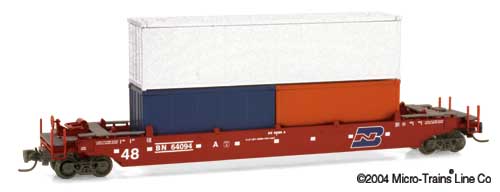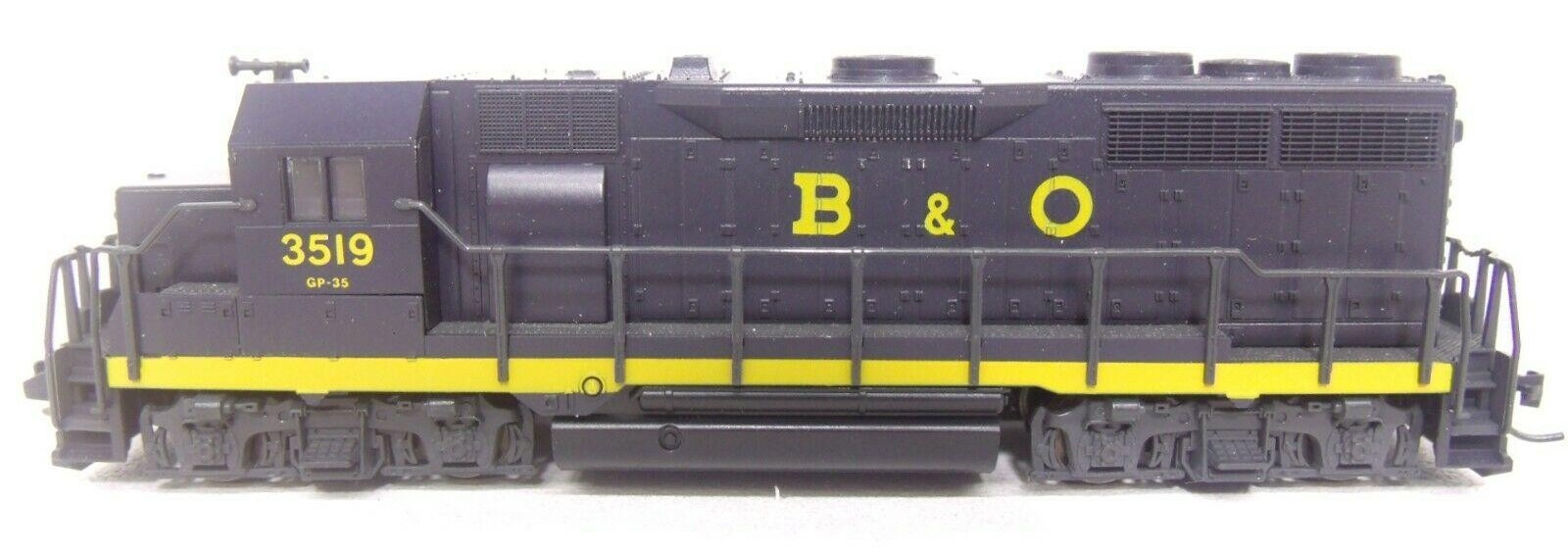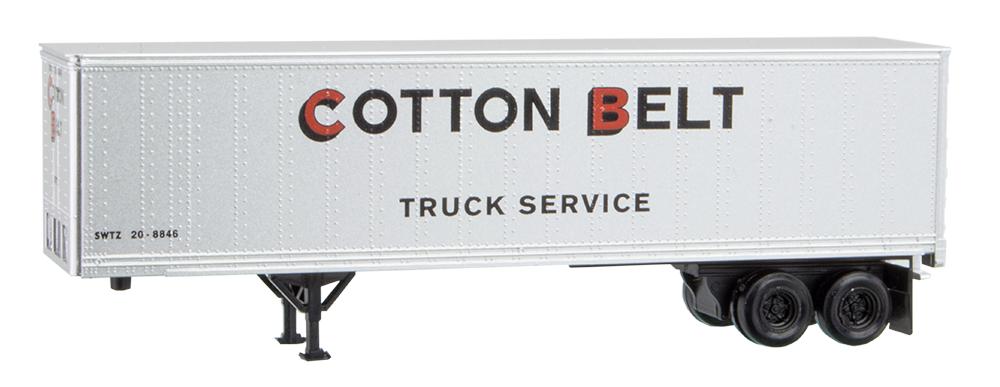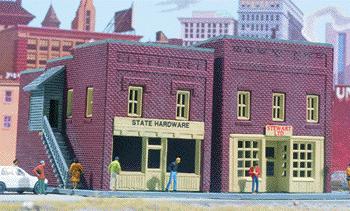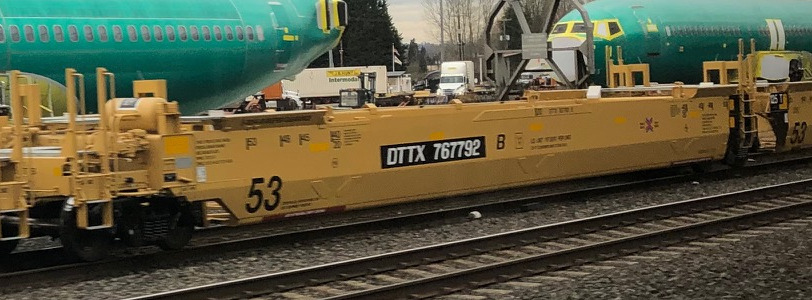Prototype History: Double-stack container trains first hit the rails for regular service in 1981. The Southern Pacific Railroad had developed the idea to provide service for the Sea- Land maritime shipping company. SP's pioneering double-stack service let Sea- Land's containers take a shortcut from the west coast to the Gulf of Mexico bypassing the Panama Canal. From prototype car to production order, the SP spent a little over four years on the double-stack development project. The SP's double-stack cars featured unwieldy bulkheads on each end to prevent the loose top container from blowing off of the car. A new group at Greenbrier Intermodal designed a similar bulkhead car, even as other companies were starting to leave the bulkheads off of their stack cars. The support for the upper container came from inter-box connectors (IBCs) which had been used for years in oceangoing container shipping. Greenbrier and their car builder, Gunderson, wanted to get in on that market, and did so with their Maxi-Stack cars. But there was another new market out there: developing a single, two-truck stack car. Almost all of the existing cars in service were articulated, with the exception of one SP prototype car.
David DeBoer, a co-founder of Greenbrier, had been seeking to fill this single-well stack car niche, despite the "intermodal experts" at Trailer Train Corp. insisting that the only single-well car that could ride smoothly was a European-style 2-axle car. (In fact, it was DeBoer who wrote the reference book I used for much of this background. His Piggyback and Containers is a highly recommended read, and it was my first review item for MRN.) DeBoer sought advice from his retired former boss at the SP. This pitted the Doubting Thomases at TTX up against Bill Thomford, who had developed the SP's double-stack prototypes. Thomford laughed off Trailer Train's existence, pointing out that his own single-well, two-truck stack car had a million miles of reliable service under its belt. DeBoer went back to Greenbrier and the company got to work designing the car that TTX said was doomed to failure.
In 1990, Gunderson turned out the Husky Stack. Test engineers proved Thomford right, and the cars tracked perfectly. Trailer Train ended up reversing their initial claims and ordering 150 Husky Stack cars built with 48-foot wells in 1991. The Burlington Northern also ordered 75 cars and other buyers lined up later. The original 1991 model cars are still going strong for many different owners, including Trailer Train.
Husky Stack development has continued today, with the introduction of 53-foot wells and the "All-Purpose" Husky Stack, with trailer hitches on each end. In Greenbrier terms, the car is named the HS53 for the 53-foot well version.
David DeBoer, a co-founder of Greenbrier, had been seeking to fill this single-well stack car niche, despite the "intermodal experts" at Trailer Train Corp. insisting that the only single-well car that could ride smoothly was a European-style 2-axle car. (In fact, it was DeBoer who wrote the reference book I used for much of this background. His Piggyback and Containers is a highly recommended read, and it was my first review item for MRN.) DeBoer sought advice from his retired former boss at the SP. This pitted the Doubting Thomases at TTX up against Bill Thomford, who had developed the SP's double-stack prototypes. Thomford laughed off Trailer Train's existence, pointing out that his own single-well, two-truck stack car had a million miles of reliable service under its belt. DeBoer went back to Greenbrier and the company got to work designing the car that TTX said was doomed to failure.
In 1990, Gunderson turned out the Husky Stack. Test engineers proved Thomford right, and the cars tracked perfectly. Trailer Train ended up reversing their initial claims and ordering 150 Husky Stack cars built with 48-foot wells in 1991. The Burlington Northern also ordered 75 cars and other buyers lined up later. The original 1991 model cars are still going strong for many different owners, including Trailer Train.
Husky Stack development has continued today, with the introduction of 53-foot wells and the "All-Purpose" Husky Stack, with trailer hitches on each end. In Greenbrier terms, the car is named the HS53 for the 53-foot well version.
Road Name History: The Burlington Northern Railroad (reporting mark BN) was a United States railroad. It was a product of a March 2, 1970, merger of four major railroads - the Great Northern Railway, Northern Pacific Railway, Spokane, Portland and Seattle Railway and the Chicago, Burlington and Quincy Railroad - as well as a few small jointly owned subsidiaries owned by the four.
Burlington Northern operated between 1970 and 1996.
Its historical lineage begins in the earliest days of railroading with the chartering in 1848 of the Chicago and Aurora Railroad, a direct ancestor line of the Chicago, Burlington and Quincy Railroad, which lends Burlington to the names of various merger-produced successors.
Burlington Northern purchased the Atchison, Topeka and Santa Fe Railway on December 31, 1996 to form the Burlington Northern and Santa Fe Railway (later renamed BNSF Railway), which was owned by the Burlington Northern Santa Fe Corporation.*
Read more on Wikipedia.
Burlington Northern operated between 1970 and 1996.
Its historical lineage begins in the earliest days of railroading with the chartering in 1848 of the Chicago and Aurora Railroad, a direct ancestor line of the Chicago, Burlington and Quincy Railroad, which lends Burlington to the names of various merger-produced successors.
Burlington Northern purchased the Atchison, Topeka and Santa Fe Railway on December 31, 1996 to form the Burlington Northern and Santa Fe Railway (later renamed BNSF Railway), which was owned by the Burlington Northern Santa Fe Corporation.*
Read more on Wikipedia.
Brand/Importer Information:  Micro-Trains Line split off from Kadee Quality Products in 1990. Kadee Quality Products originally got involved in N-Scale by producing a scaled-down version of their successful HO Magne-Matic knuckle coupler system. This coupler was superior to the ubiquitous 'Rapido' style coupler due to two primary factors: superior realistic appearance and the ability to automatically uncouple when stopped over a magnet embedded in a section of track. The success of these couplers in N-Scale quickly translated to the production of trucks, wheels and in 1972 a release of ready-to-run box cars.
Micro-Trains Line split off from Kadee Quality Products in 1990. Kadee Quality Products originally got involved in N-Scale by producing a scaled-down version of their successful HO Magne-Matic knuckle coupler system. This coupler was superior to the ubiquitous 'Rapido' style coupler due to two primary factors: superior realistic appearance and the ability to automatically uncouple when stopped over a magnet embedded in a section of track. The success of these couplers in N-Scale quickly translated to the production of trucks, wheels and in 1972 a release of ready-to-run box cars.
Micro-Trains Line Co. split off from Kadee in 1990 to form a completely independent company. For this reason, products from this company can appear with labels from both enterprises. Due to the nature of production idiosyncrasies and various random factors, the rolling stock from Micro-Trains can have all sorts of interesting variations in both their packaging as well as the products themselves. When acquiring an MTL product it is very important to understand these important production variations that can greatly enhance (or decrease) the value of your purchase.

Micro-Trains Line Co. split off from Kadee in 1990 to form a completely independent company. For this reason, products from this company can appear with labels from both enterprises. Due to the nature of production idiosyncrasies and various random factors, the rolling stock from Micro-Trains can have all sorts of interesting variations in both their packaging as well as the products themselves. When acquiring an MTL product it is very important to understand these important production variations that can greatly enhance (or decrease) the value of your purchase.
Item created by: petecduffy on 2019-05-08 21:41:53. Last edited by gdm on 2021-08-03 08:45:47
If you see errors or missing data in this entry, please feel free to log in and edit it. Anyone with a Gmail account can log in instantly.
If you see errors or missing data in this entry, please feel free to log in and edit it. Anyone with a Gmail account can log in instantly.


